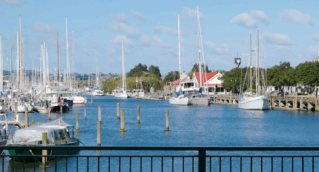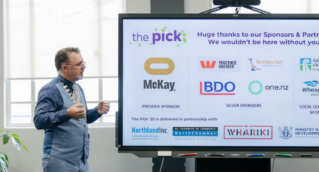15 July 2023
Ben Haselden, Marine Commercial Manager, reflects on his time at the Electric & Hybrid Marine Expo.

It’s been three years since our attendance at the Electric and Hybrid Marine expo and conference, and during this hiatus, we witnessed a pandemic and delivered our very own high-speed, carbon fibre electric ferry. So, what exactly has changed in the sector? Ben tells us below.
On a global scale, the world’s maritime fleet, from commercial to recreational, has had a major drive in technology adoption. This change is prompted by climate change and the direction our planet is heading towards. It’s up to us to acknowledge and respond to these changes in different ways.
The Electric & Hybrid Marine Expo was an opportunity to witness thousands of people joining and sharing outstanding and inspirational stories of their successes, failures, and experiences. It was also an opportunity to witness new technology on display, rekindle face-to-face dealings, and most importantly, share the same drive and passion irrespective of the company you represent which brings me to my key highlights:
1. Demand vs Supply
One major highlight for me was the current balance or imbalance that is becoming evident from the drive for emission reducing technology. The industry is delicately teetering with not enough supply for the current adoption trends, and not enough adoption to drive the development of supply. At an adoption rate, so far in single digit percentages, we are already seeing long lead times and the industry’s inability to deliver the technology the world is so desperately needing. A distinct lack of supply is forcing alternative ideas and in turn, some major corner cutting in the adoption. How can the industry ramp supply to meet the demand that doesn’t then force a rise in capital needed for premium, high demand products? Economies of Scale, right? Changes to ports, ships and rules mean that costs are set to rise. No matter what is imposed, we will see the negative of the user pays scenario and that is most likely down to us, the consumers.
We saw the fascinating panel discussion of the Port of Dover’s green corridor between Calais and Dunkirk. An ambitious world first to run a carbon zero shipping passage between England and France through one of the UK’s busiest freight routes. The studies initially recognised the lack of supply in technology so some first steps were adopted to help them meet their initial, internal goals which brings me to my next point.
2. Alternative Fuels
With the port of Dover example, their initial roll out was to adopt alternate fuels into their current fleet, in a step to drop emissions towards their overall project. Their initial achievements have been met by adopting recycled HVO (Hydrotreated Vegetable Oil from cooking oils etc.) and achieving a near 90% reduction in emissions. Sure, there’s a trade-off to using HVO in both performance and cost, but in their calculations, the capital expenditure required to convert to other alternate fuels and stored energy technologies would have meant a premature end to their assets and therefore a poor cost benefit ratio.
Alternate fuels were the hottest topic over the conference. A tricky energy storage market is paving the way for fuels but the two still need to work with one another. Ammonia fuels, methanol, HVO and Hydrogen are all emerging alternatives that for the first time in a long time, seem to be making inroads. Some of these options have a near instant adoption and some have some major setbacks in terms of cost and adoption. For me, the adoption of HVO fuels (and other fuels) pose more of a moral dilemma than that of saving the planet. For an example, the more that recycled HVO is adopted, the more the limited supply is depleted which then turns to new lipid vegetable and tallow oils. So, what’s the issue there? Well, increase the demand on the new oils and you effectively start to potentially take food away from humans and increase the strain on the environment in other areas. You shift the focus of an industry reducing emissions to an industry trying to keep up with a new demand which in turn, negates the original industry’s gains in reducing emissions. The same can be said for Green, and brown hydrogen fuels and what about the potential environmental disaster from the first ammonia powered vessel spilling its fuel? I can bet you right now, the fallout from the latter will far negate the CO2 emissions the vessel tried to save.
3. Battery and Energy Storage
This sector highlighted the volatility that the marine energy storage industry is facing. With merely days before the show, the Sensata owned Spear technologies, announced they were exiting the marine market effective almost immediately. Having just released a new product, which, on paper looked promising, proved just how temperamental things are. The entire BESS industry seems to be a tight battle of not only supply constraints but financial competition. The recent changes in rule sets and a drive for safety have no doubt affected some companies but the laypersons observation locks firmly on the drive for reliability, safety and niche attributes over the competition. Form factors, energy density and ambidexterity for different role profiles.
The next item can almost be a standalone point, but it’s something that now follows the BESS sector strongly and that is the charging and Port infrastructure game. The reason I won’t highlight it in its own section is that as the industry rolls out its needs with shore and port infrastructure, the game gets harder. An already stretched worldwide grid is proving that as the requirement for fast charging and that ability to accept that charge through the likes of the needed MCS (megawatt charge system), the ability to supply the demand gets even tighter. This is where BESS becomes wider than just in the vessel. Landmark projects are already recognising that as their grids currently stand, they can’t meet those demands with the example of Dover’s estimated demand being 160mvA! There now becomes a demand for battery manufacturers to diversify further and in turn, regulatory bodies joining forces between ship and shore.
With technology, an interestingly tight-lipped response was offered from most manufacturers. My feelings are that the marine battery market has momentarily flattened in the technology race and the primary focus is for improved safety, reliability and more so delivery on a stretched supply chain. If you want to see battery technology, watch the EV market and the trickle-down effects that has on the marine market thereafter. The EV market is the marine worlds’ guinea pig in development, which is warming to think that we, as integrators, can rely on the current technology and our learnings for a bit longer.
4. Real world experiences
With a three-year hiatus for me from this event, I had expected to see more case studies about real world adoptions of fully electric propulsion especially in the passenger ferry sense. The technology is proven, the operational savings are documented and the real-world examples are proving that organisations and operators should be either changing or have changed. The Ms Medstraum, our own Ika Rere and a partially stalled beluga 24 are projects we should have seen as decimal points in a list much longer. Instead we didn’t and we can place them the worlds major examples of this technology. More case studies are underway although appear focused around hopes and dreams; which offers an insight into the industry. Is the industry gun shy from both technology and the financial risk, or are they just purely running with no intention of “putting their money where their mouths are”? For me, the sitting and waiting for operators is fast becoming a thing of the past but that poses further risk. Be the first adopters and pay more but receive earlier, or wait and pay less but receive later while running the gauntlet of rumored tariffs, noncompliance and increasing Opex.
For me, the biggest learning is that we, a “little” by world standards, electrical integrator from New Zealand is not only playing the right game in this space, we are a leading player in a pond that is much bigger. Our success with the Ika Rere is a world leading solution and we know that come the next, we will beat the world again to deliver something we can be even more proud of and can add to the list of real world data at the next conference.



